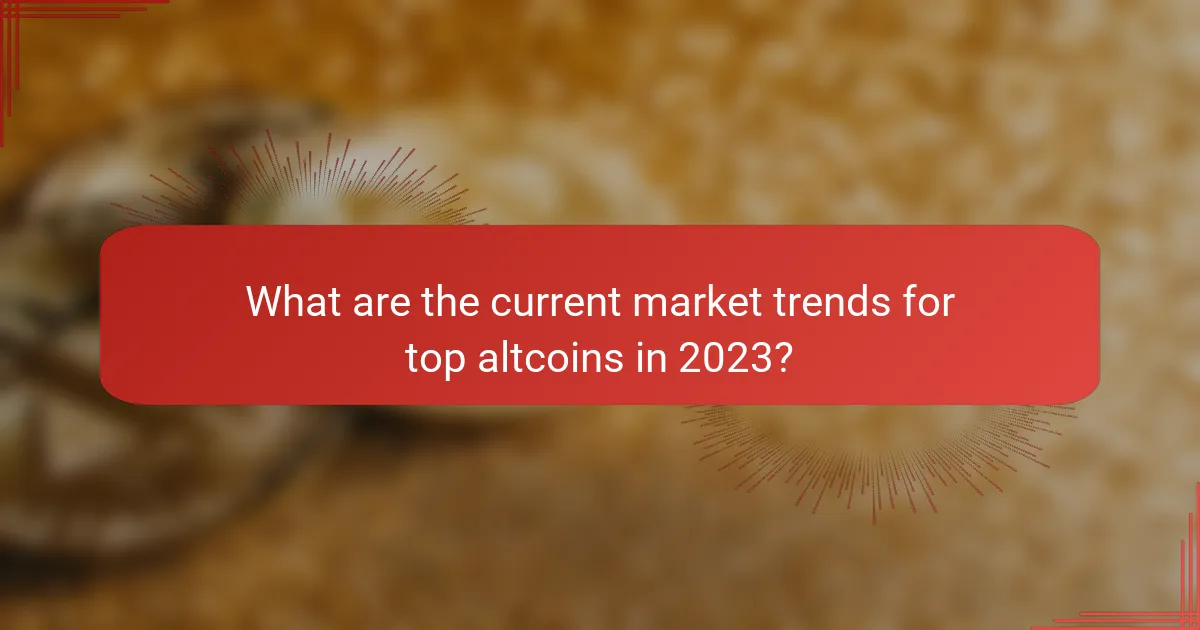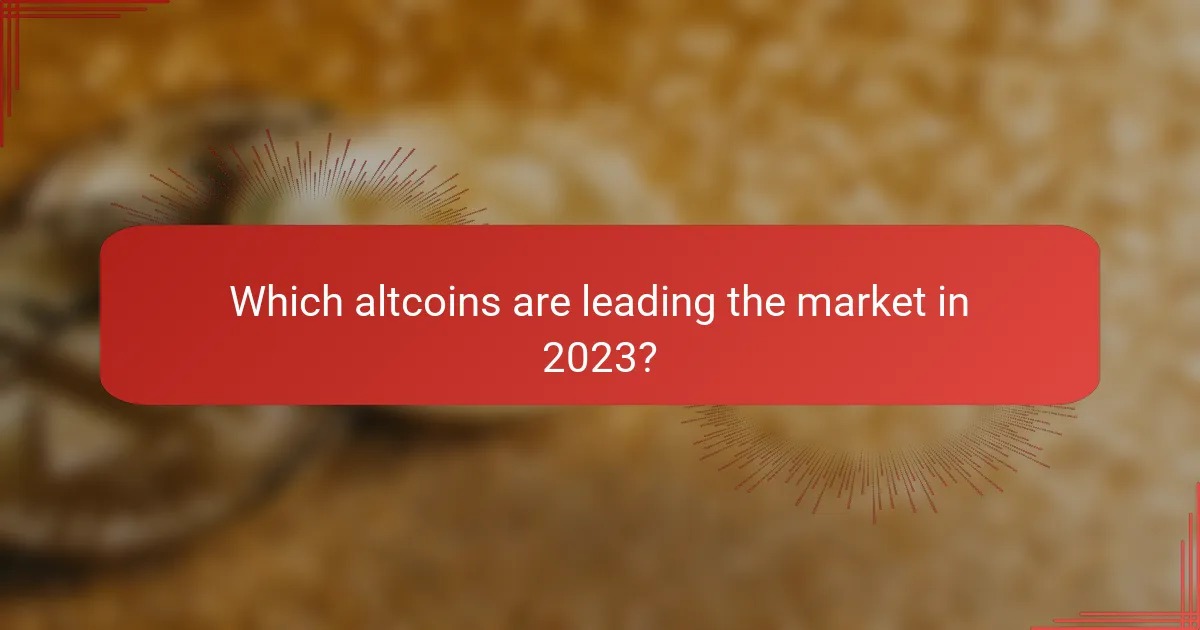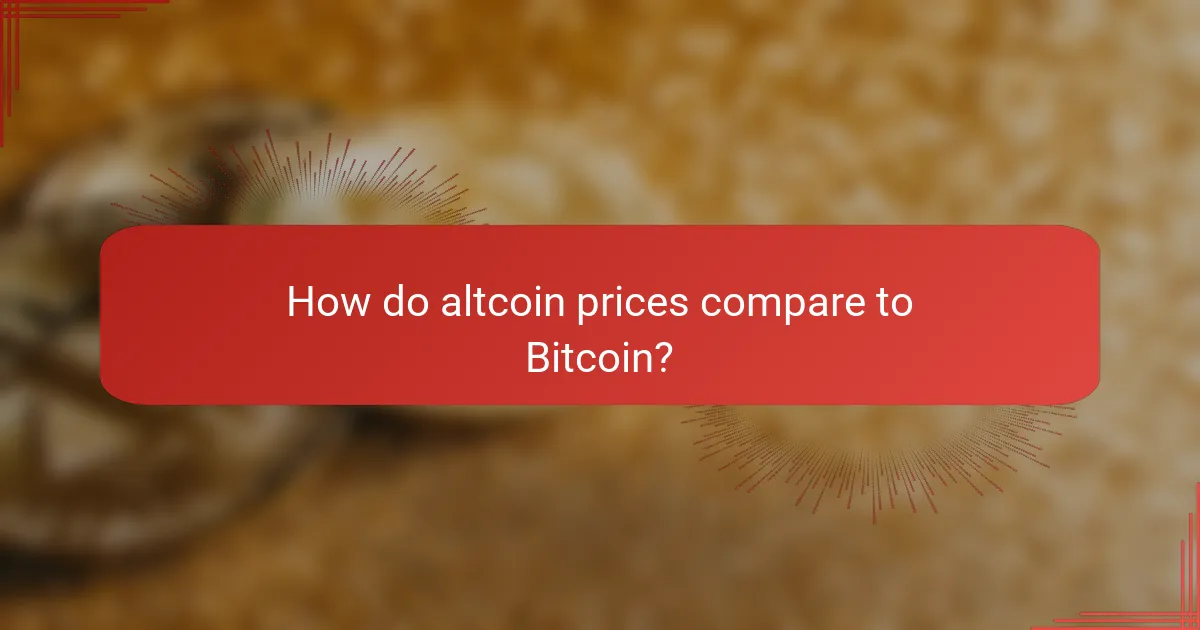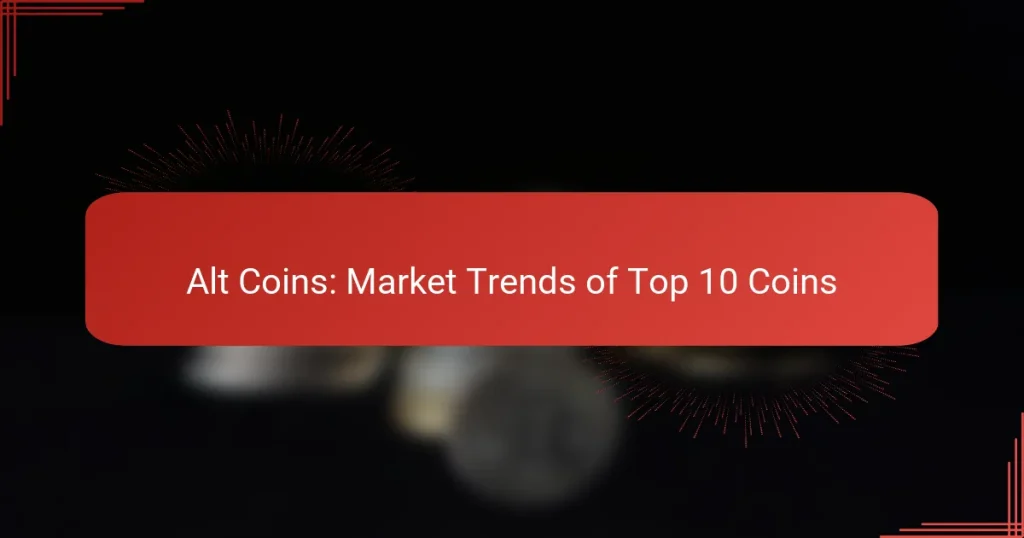In 2023, the altcoin market is experiencing notable trends, driven by the adoption of Ethereum 2.0 and a surge in interest for Solana within decentralized finance (DeFi). Key players like Cardano and Binance Coin are also making headlines, showcasing their unique features and growth potential. As market volatility continues to shape the landscape, understanding the dynamics of these top altcoins is essential for investors navigating this evolving space.

What are the current market trends for top altcoins in 2023?
In 2023, the altcoin market is witnessing significant trends, particularly with Ethereum 2.0’s adoption, growing interest in Solana for decentralized finance (DeFi), and the rise of Layer 2 solutions. Market volatility continues to impact Bitcoin alternatives, while institutional investment is increasingly directed towards Cardano.
Increased adoption of Ethereum 2.0
Ethereum 2.0 is gaining traction as more users and developers transition to the upgraded network, which promises enhanced scalability and lower transaction fees. This shift is driven by the move from a proof-of-work to a proof-of-stake consensus mechanism, allowing users to earn rewards by staking their ETH.
As Ethereum 2.0 matures, it is expected to support a wider range of applications, making it a more attractive option for developers and investors alike. The ongoing improvements are likely to solidify Ethereum’s position as a leading platform in the altcoin space.
Growing interest in Solana for DeFi
Solana is emerging as a popular choice for decentralized finance (DeFi) projects due to its high throughput and low transaction costs. With the ability to handle thousands of transactions per second, Solana is appealing to developers looking to build scalable DeFi applications.
Investors are increasingly recognizing Solana’s potential, leading to a surge in its market capitalization. As more DeFi projects launch on the Solana network, its ecosystem is expected to expand, attracting further interest and investment.
Rise of Layer 2 solutions like Polygon
Layer 2 solutions, particularly Polygon, are gaining momentum as they address Ethereum’s scalability issues by enabling faster and cheaper transactions. These solutions allow users to conduct transactions off the main Ethereum chain, reducing congestion and fees.
The adoption of Layer 2 technologies is crucial for the growth of decentralized applications (dApps) and DeFi platforms. As more users migrate to these solutions, the overall efficiency of the Ethereum network is expected to improve, benefiting the entire altcoin market.
Market volatility impacting Bitcoin alternatives
Market volatility continues to influence the performance of Bitcoin alternatives, with many altcoins experiencing significant price fluctuations. This volatility can create both opportunities and risks for investors, as rapid price changes may lead to substantial gains or losses.
Investors should remain cautious and consider diversifying their portfolios to mitigate risks associated with market swings. Keeping an eye on market trends and news can help in making informed decisions regarding altcoin investments.
Institutional investment in Cardano
Cardano is attracting increasing institutional investment, driven by its strong fundamentals and commitment to sustainability. The platform’s focus on academic research and peer-reviewed development enhances its credibility among institutional investors.
As more institutions allocate funds to Cardano, its market presence is likely to grow, potentially leading to increased adoption and utility. Investors should monitor institutional trends as they can significantly impact Cardano’s price and market dynamics.

Which altcoins are leading the market in 2023?
In 2023, several altcoins are dominating the cryptocurrency market, with Ethereum, Binance Coin, Cardano, Solana, and Ripple standing out. These coins are recognized for their unique features, market performance, and potential for growth, making them key players in the altcoin space.
Ethereum (ETH)
Ethereum remains the leading altcoin in 2023, primarily due to its smart contract functionality and robust decentralized application (dApp) ecosystem. It serves as a platform for various projects, enabling developers to create and deploy their applications seamlessly.
Investors should consider Ethereum’s transition to a proof-of-stake consensus mechanism, which aims to improve scalability and reduce energy consumption. This shift has attracted more institutional interest, potentially increasing its market value.
Binance Coin (BNB)
Binance Coin is the native cryptocurrency of the Binance exchange and has gained traction due to its utility within the Binance ecosystem. Users can utilize BNB for trading fee discounts, participating in token sales, and making payments on various platforms.
The coin’s value is closely tied to the performance of the Binance exchange, making it essential for investors to monitor exchange activity and regulatory developments. BNB has shown resilience and growth, making it a popular choice for traders.
Cardano (ADA)
Cardano is recognized for its research-driven approach and strong focus on security and sustainability. Its unique proof-of-stake algorithm, Ouroboros, allows for energy-efficient transactions while maintaining a high level of security.
Investors should pay attention to Cardano’s ongoing developments and partnerships, as they can significantly impact its adoption and price. The platform’s emphasis on scalability and interoperability positions it well for future growth in the altcoin market.
Solana (SOL)
Solana has emerged as a high-performance blockchain known for its fast transaction speeds and low fees. This has made it a popular choice for developers looking to build decentralized applications and DeFi projects.
Investors should be aware of Solana’s rapid growth and the increasing number of projects being launched on its platform. However, they should also consider the potential risks associated with network outages and competition from other blockchains.
Ripple (XRP)
Ripple focuses on facilitating cross-border payments and has established partnerships with various financial institutions. Its unique consensus algorithm allows for quick and cost-effective transactions, making it appealing for banks and payment providers.
Investors should keep an eye on Ripple’s ongoing legal challenges, particularly with the U.S. Securities and Exchange Commission (SEC). The outcome of these proceedings could significantly influence XRP’s market position and future growth potential.

How do altcoin prices compare to Bitcoin?
Altcoin prices generally fluctuate more than Bitcoin, reflecting their higher volatility and market dynamics. While Bitcoin often serves as a benchmark, many altcoins can experience significant price swings, influenced by factors such as market sentiment and technological developments.
Altcoins often show higher volatility
Altcoins are known for their pronounced price volatility, which can be several times greater than that of Bitcoin. This volatility is often driven by lower market capitalization and trading volume, making them more susceptible to rapid price changes.
For example, while Bitcoin may see daily fluctuations of a few percent, some altcoins can swing by double digits within the same timeframe. Traders should be prepared for these sharp movements, which can present both opportunities and risks.
Correlation with Bitcoin price movements
Many altcoins exhibit a strong correlation with Bitcoin price movements, often following its trends closely. When Bitcoin experiences a price increase or decrease, altcoins typically react in a similar manner, although the degree of correlation can vary.
Investors should monitor Bitcoin’s performance as it can significantly influence altcoin prices. However, some altcoins may decouple from Bitcoin trends during specific market events or due to unique developments within their ecosystems.
Market cap differences between altcoins and Bitcoin
Bitcoin commands the largest market capitalization in the cryptocurrency space, often accounting for a significant portion of the total market. In contrast, altcoins vary widely in market cap, with many being classified as small-cap or mid-cap assets.
This disparity in market capitalization affects liquidity and price stability. Larger altcoins may offer more stability, while smaller ones can be highly speculative. Investors should consider market cap when evaluating altcoin investments, as it can impact potential returns and risks.

What factors influence altcoin market trends?
Altcoin market trends are primarily influenced by technological advancements, regulatory changes, and market sentiment. Understanding these factors can help investors make informed decisions and anticipate price movements.
Technological advancements and upgrades
Technological improvements, such as network upgrades or new features, can significantly impact altcoin values. For example, the implementation of smart contracts or enhancements in transaction speed can attract more users and investors.
Investors should pay attention to upcoming upgrades, as they often lead to increased trading volumes and price surges. Keeping track of development roadmaps and community engagement can provide insights into potential market movements.
Regulatory changes affecting cryptocurrency
Regulatory developments can create substantial shifts in altcoin markets. Changes in laws regarding cryptocurrency trading, taxation, or initial coin offerings (ICOs) can either bolster or hinder market confidence.
For instance, favorable regulations in a major economy can lead to increased adoption, while strict regulations may drive investors away. Staying informed about local and international regulatory news is crucial for anticipating market reactions.
Market sentiment and social media trends
Market sentiment, often reflected in social media discussions, plays a vital role in shaping altcoin trends. Positive news or endorsements from influential figures can lead to rapid price increases, while negative sentiment can trigger sell-offs.
Monitoring platforms like Twitter, Reddit, and specialized crypto forums can provide valuable insights into public perception. Investors should be cautious of hype and perform due diligence before making investment decisions based on social media trends.


